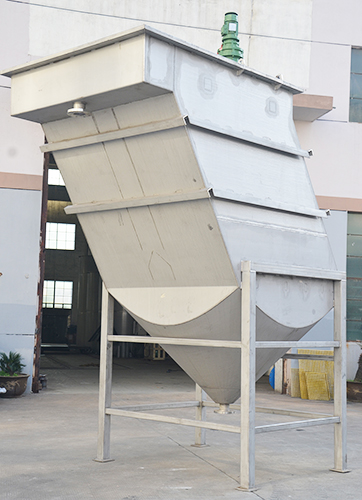Views: 888 Author: Yosun Publish Time: 2025-10-10 Origin: Site









Industrial growth has significantly improved global living standards, but it has also created new environmental hazards that threaten ecosystems and human health. Among these, industrial wastewater is one of the most critical challenges. It contains a mixture of chemicals, oils, heavy metals, and suspended solids that, if untreated, can cause severe soil and water contamination.
To address these hazards, modern industrial wastewater treatment processes employ advanced physical, chemical, and biological methods. Among the most efficient solutions available today are the Dissolved Air Flotation (DAF) system and the Lamella Clarifier, both of which play a vital role in mitigating pollution and achieving sustainable water management.
Industrial wastewater varies widely depending on the source—food processing, petrochemical refining, textile dyeing, or metal finishing—but it consistently presents risks such as:
Water contamination: Untreated discharge can pollute surface and groundwater sources.
Soil degradation: Toxic compounds infiltrate soil layers, affecting agriculture and vegetation.
Aquatic ecosystem damage: High concentrations of nutrients and suspended solids reduce oxygen levels, harming aquatic life.
Human health risks: Exposure to contaminated water can cause diseases, poisoning, or long-term health issues.
These environmental hazards make proper wastewater management essential for every industrial sector.
Industrial wastewater treatment aims to remove pollutants and make water safe for reuse or discharge. The process typically includes several stages—pretreatment, primary clarification, secondary biological treatment, and tertiary polishing. Each stage contributes to reducing pollutant loads and meeting environmental standards.
Modern systems combine traditional treatment methods with innovative mechanical solutions such as DAF dissolved air flotation and Lamella Clarifiers, which enhance solid-liquid separation efficiency while minimizing space and energy use.
Dissolved Air Flotation is a physical separation process used to remove suspended solids, oils, and grease from industrial effluents. In a DAF unit, air is dissolved into water under pressure and released as microbubbles into the flotation tank. These bubbles attach to particles, reducing their density and causing them to float. A skimming device then removes the floated layer, leaving clear water beneath.
Highly efficient removal of fats, oils, and grease (FOG)
Compact design suitable for space-limited facilities
High throughput and continuous operation
Reduces downstream biological load
Ideal for industries such as food and beverage, dairy, and petrochemical processing
At Yosun, we design and manufacture advanced DAF systems engineered to handle variable flow conditions and heavy contamination loads, ensuring compliance with international discharge standards.
The Lamella Clarifier, also known as an inclined plate clarifier, is another critical component in industrial wastewater treatment. It enhances sedimentation by using multiple inclined plates, dramatically increasing the effective settling area. Solids settle onto the plates and slide down into a sludge hopper, while clarified water exits from the top.

Handles large flow rates in a compact footprint
Provides efficient solid-liquid separation
Requires low maintenance due to minimal moving parts
Integrates easily with chemical coagulation systems
Reduces overall plant size and construction costs
In many treatment plants, DAF systems are used for light suspended matter like oils and organic particles, while Lamella Clarifiers manage heavier solids. This combination offers a comprehensive solution for tackling various types of industrial wastewater.
The integration of Dissolved Air Flotation and Lamella Clarifiers plays a major role in minimizing environmental hazards associated with industrial effluents. Together, these systems remove contaminants that would otherwise pose threats to ecosystems and public health.
For example:
In food processing wastewater, DAF units efficiently separate fats and proteins, preventing eutrophication.
In metal finishing plants, Lamella Clarifiers help settle heavy metal hydroxides, reducing toxic discharges.
In petrochemical industries, both systems work together to remove oil residues and fine suspended solids before biological treatment.
By reducing chemical oxygen demand (COD), biological oxygen demand (BOD), and suspended solids, these technologies support cleaner discharges and improved environmental compliance.
Wastewater from this sector contains high concentrations of organic matter, starch, and fats. DAF systems remove oils and grease, while Lamella Clarifiers separate solids formed during coagulation.
DAF units recover oil for reuse, and Lamella Clarifiers provide efficient sedimentation for heavy particulates.
High color intensity and suspended solids are common hazards. The combination of coagulation, DAF, and Lamella clarification removes dyes and solid residues effectively.
Heavy metals and fine mineral particles require precise sedimentation. Lamella Clarifiers handle these loads efficiently, preventing hazardous metal pollution.
Compact DAF and Lamella systems serve as pre-treatment or polishing stages to stabilize effluent quality and enhance final filtration.
When implementing DAF dissolved air flotation and Lamella Clarifiers in industrial wastewater treatment, engineers must consider several factors:
Influent characteristics: Type, concentration, and particle size of contaminants.
Flow rate and hydraulic load: Determines system capacity and retention time.
Material selection: Stainless steel and corrosion-resistant coatings ensure longevity.
Automation: PLC controls optimize air saturation, flow regulation, and sludge removal.
Energy efficiency: DAF units with optimized air injection reduce power consumption, while Lamella Clarifiers minimize pumping needs.
At Yosun, sustainability is at the heart of our system design. Our solutions reduce chemical use, energy demand, and sludge production—directly addressing global environmental concerns.
Using advanced technologies like Dissolved Air Flotation and Lamella Clarifiers contributes to reducing environmental hazards on multiple levels:
Water conservation: Treated water can be safely reused for non-potable applications.
Lower emissions: Reduced sludge volumes mean lower carbon emissions during disposal.
Resource recovery: Oils and solids removed through DAF can often be recycled or repurposed.
Regulatory compliance: Helps industries meet tightening global discharge standards.
These benefits align with modern sustainability goals, making industrial wastewater treatment both an environmental and economic priority.
The future of industrial wastewater treatment is focused on automation, digital monitoring, and hybrid technologies that combine flotation, sedimentation, and filtration in a single compact system. As stricter environmental regulations continue to emerge, DAF dissolved air flotation and Lamella Clarifiers will remain indispensable components for safe, efficient, and sustainable wastewater management worldwide.
